Paper Menu >>
Journal Menu >>
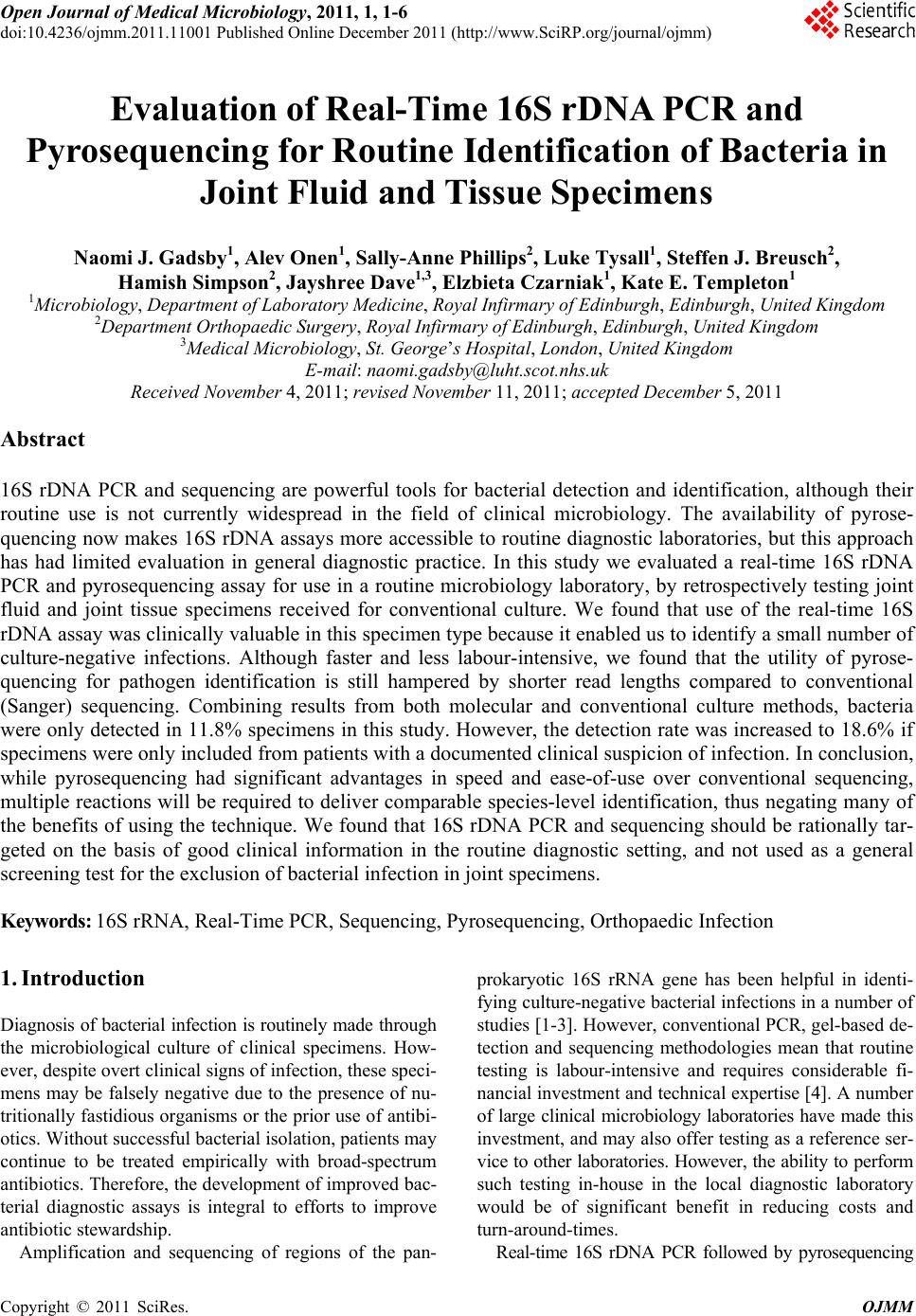 Open Journal of Medical Microbiology, 2011, 1, 1-6 doi:10.4236/ojmm.2011.11001 Published Online December 2011 (http://www.SciRP.org/journal/ojmm) Copyright © 2011 SciRes. OJMM Evaluation of Real-Time 16S rDNA PCR and Pyrosequencing for Routine Identification of Bacteria in Joint Fluid and Tissue Specimens Naomi J. Gadsby1, Alev Onen1, Sally-Anne Phillips2, Luke Tysall1, Steffen J. Breusch2, Hamish Simpson2, Jayshree Dave1,3, Elzbieta Czarniak1, Kate E. Templeton1 1Microbiology, Department of Laboratory Medicine, Royal Infirmary of Edinburgh, Edinburgh, Uni t e d K i ng dom 2Department Orthopaedic Surgery, Royal Infirmary of Edinburgh, Edinburgh, United Kingdom 3Medical Microbiology, St. G e orge’s Hospital, London, United Kingdom E-mail: naomi.gadsby@luht.scot.nhs.uk Received November 4, 2011; revised November 11, 2011; accepted December 5, 2011 Abstract 16S rDNA PCR and sequencing are powerful tools for bacterial detection and identification, although their routine use is not currently widespread in the field of clinical microbiology. The availability of pyrose- quencing now makes 16S rDNA assays more accessible to routine diagnostic laboratories, but this approach has had limited evaluation in general diagnostic practice. In this study we evaluated a real-time 16S rDNA PCR and pyrosequencing assay for use in a routine microbiology laboratory, by retrospectively testing joint fluid and joint tissue specimens received for conventional culture. We found that use of the real-time 16S rDNA assay was clinically valuable in this specimen type because it enabled us to identify a small number of culture-negative infections. Although faster and less labour-intensive, we found that the utility of pyrose- quencing for pathogen identification is still hampered by shorter read lengths compared to conventional (Sanger) sequencing. Combining results from both molecular and conventional culture methods, bacteria were only detected in 11.8% specimens in this study. However, the detection rate was increased to 18.6% if specimens were only included from patients with a documented clinical suspicion of infection. In conclusion, while pyrosequencing had significant advantages in speed and ease-of-use over conventional sequencing, multiple reactions will be required to deliver comparable species-level identification, thus negating many of the benefits of using the technique. We found that 16S rDNA PCR and sequencing should be rationally tar- geted on the basis of good clinical information in the routine diagnostic setting, and not used as a general screening test for the exclusion of bacterial infection in joint specimens. Keywords: 16S rRNA, Real-Time PCR, Sequencing, Pyrosequencing, Orthopaedic Infection 1. Introduction Diagnosis of bacterial infection is routinely made through the microbiological culture of clinical specimens. How- ever, despite overt clinical signs of infection, these speci- mens may be falsely negative due to the presence of nu- tritionally fastidious organisms or the prior use of antibi- otics. Without successful bacterial isolation, patients may continue to be treated empirically with broad-spectrum antibiotics. Therefore, the development of improved bac- terial diagnostic assays is integral to efforts to improve antibiotic stewardship. Amplification and sequencing of regions of the pan- prokaryotic 16S rRNA gene has been helpful in identi- fying culture-negative bacterial infections in a number of studies [1-3]. However, conventional PCR, gel-based de- tection and sequencing methodologies mean that routine testing is labour-intensive and requires considerable fi- nancial investment and technical expertise [4]. A number of large clinical microbiology laboratories have made this investment, and may also offer testing as a reference ser- vice to other laboratories. However, the ability to perform such testing in-house in the local diagnostic laboratory would be of significant benefit in reducing costs and turn-around-times. Real-time 16S rDNA PCR followed by pyrosequencing 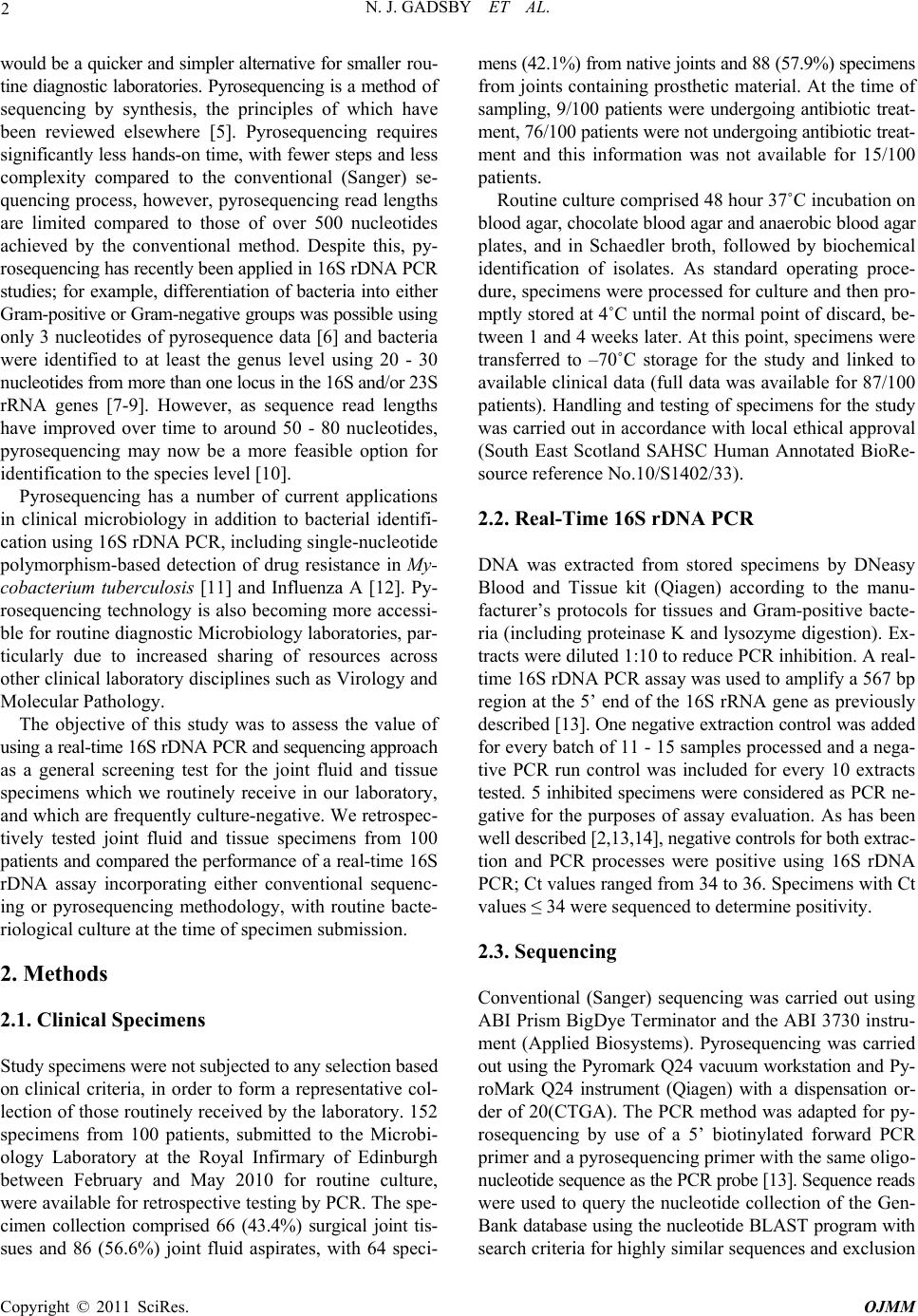 N. J. GADSBY ET AL. Copyright © 2011 SciRes. OJMM 2 would be a quicker and simpler alternative for smaller rou- tine diagnostic laboratories. Pyrosequencing is a method of sequencing by synthesis, the principles of which have been reviewed elsewhere [5]. Pyrosequencing requires significantly less hands-on time, with fewer steps and less complexity compared to the conventional (Sanger) se- quencing process, however, pyrosequencing read lengths are limited compared to those of over 500 nucleotides achieved by the conventional method. Despite this, py- rosequencing has recently been applied in 16S rDNA PCR studies; for example, differentiation of bacteria into either Gram-positive or Gram-negative groups was possible using only 3 nucleotides of pyrosequence data [6] and bacteria were identified to at least the genus level using 20 - 30 nucleotides from more than one locus in the 16S and/or 23S rRNA genes [7-9]. However, as sequence read lengths have improved over time to around 50 - 80 nucleotides, pyrosequencing may now be a more feasible option for identification to the species level [10]. Pyrosequencing has a number of current applications in clinical microbiology in addition to bacterial identifi- cation using 16S rDNA PCR, including single-nucleotide polymorphism-based detection of drug resistance in My- cobacterium tuberculosis [11] and Influenza A [12]. Py- rosequencing technology is also becoming more accessi- ble for routine diagnostic Microbiology laboratories, par- ticularly due to increased sharing of resources across other clinical laboratory disciplines such as Virology and Molecular Pathology. The objective of this study was to assess the value of using a real-time 16S rDNA PCR and sequencing approach as a general screening test for the joint fluid and tissue specimens which we routinely receive in our laboratory, and which are frequently culture-negative. We retrospec- tively tested joint fluid and tissue specimens from 100 patients and compared the performance of a real-time 16S rDNA assay incorporating either conventional sequenc- ing or pyrosequencing methodology, with routine bacte- riological culture at the time of specimen submission. 2. Methods 2.1. Clinical Specimens Study specimens were not subjected to any selection based on clinical criteria, in order to form a representative col- lection of those routinely received by the laboratory. 152 specimens from 100 patients, submitted to the Microbi- ology Laboratory at the Royal Infirmary of Edinburgh between February and May 2010 for routine culture, were available for retrospective testing by PCR. The spe- cimen collection comprised 66 (43.4%) surgical joint tis- sues and 86 (56.6%) joint fluid aspirates, with 64 speci- mens (42.1%) from native joints and 88 (57.9%) specimens from joints containing prosthetic material. At the time of sampling, 9/100 patients were undergoing antibiotic treat- ment, 76/100 patients were not undergoing antibiotic treat- ment and this information was not available for 15/100 patients. Routine culture comprised 48 hour 37˚C incubation on blood agar, chocolate blood agar and anaerobic blood agar plates, and in Schaedler broth, followed by biochemical identification of isolates. As standard operating proce- dure, specimens were processed for culture and then pro- mptly stored at 4˚C until the normal point of discard, be- tween 1 and 4 weeks later. At this point, specimens were transferred to –70˚C storage for the study and linked to available clinical data (full data was available for 87/100 patients). Handling and testing of specimens for the study was carried out in accordance with local ethical approval (South East Scotland SAHSC Human Annotated BioRe- source reference No.10/S1402/33). 2.2. Real-Time 16S rDNA PCR DNA was extracted from stored specimens by DNeasy Blood and Tissue kit (Qiagen) according to the manu- facturer’s protocols for tissues and Gram-positive bacte- ria (including proteinase K and lysozyme digestion). Ex- tracts were diluted 1:10 to reduce PCR inhibition. A real- time 16S rDNA PCR assay was used to amplify a 567 bp region at the 5’ end of the 16S rRNA gene as previously described [13]. One negative extraction control was added for every batch of 11 - 15 samples processed and a nega- tive PCR run control was included for every 10 extracts tested. 5 inhibited specimens were considered as PCR ne- gative for the purposes of assay evaluation. As has been well described [2,13,14], negative controls for both extrac- tion and PCR processes were positive using 16S rDNA PCR; Ct values ranged from 34 to 36. Specimens with Ct values ≤ 34 were sequenced to determine positivity. 2.3. Sequencing Conventional (Sanger) sequencing was carried out using ABI Prism BigDye Terminator and the ABI 3730 instru- ment (Applied Biosystems). Pyrosequencing was carried out using the Pyromark Q24 vacuum workstation and Py- roMark Q24 instrument (Qiagen) with a dispensation or- der of 20(CTGA). The PCR method was adapted for py- rosequencing by use of a 5’ biotinylated forward PCR primer and a pyrosequencing primer with the same oligo- nucleotide sequence as the PCR probe [13]. Sequence reads were used to query the nucleotide collection of the Gen- Bank database using the nucleotide BLAST program with search criteria for highly similar sequences and exclusion 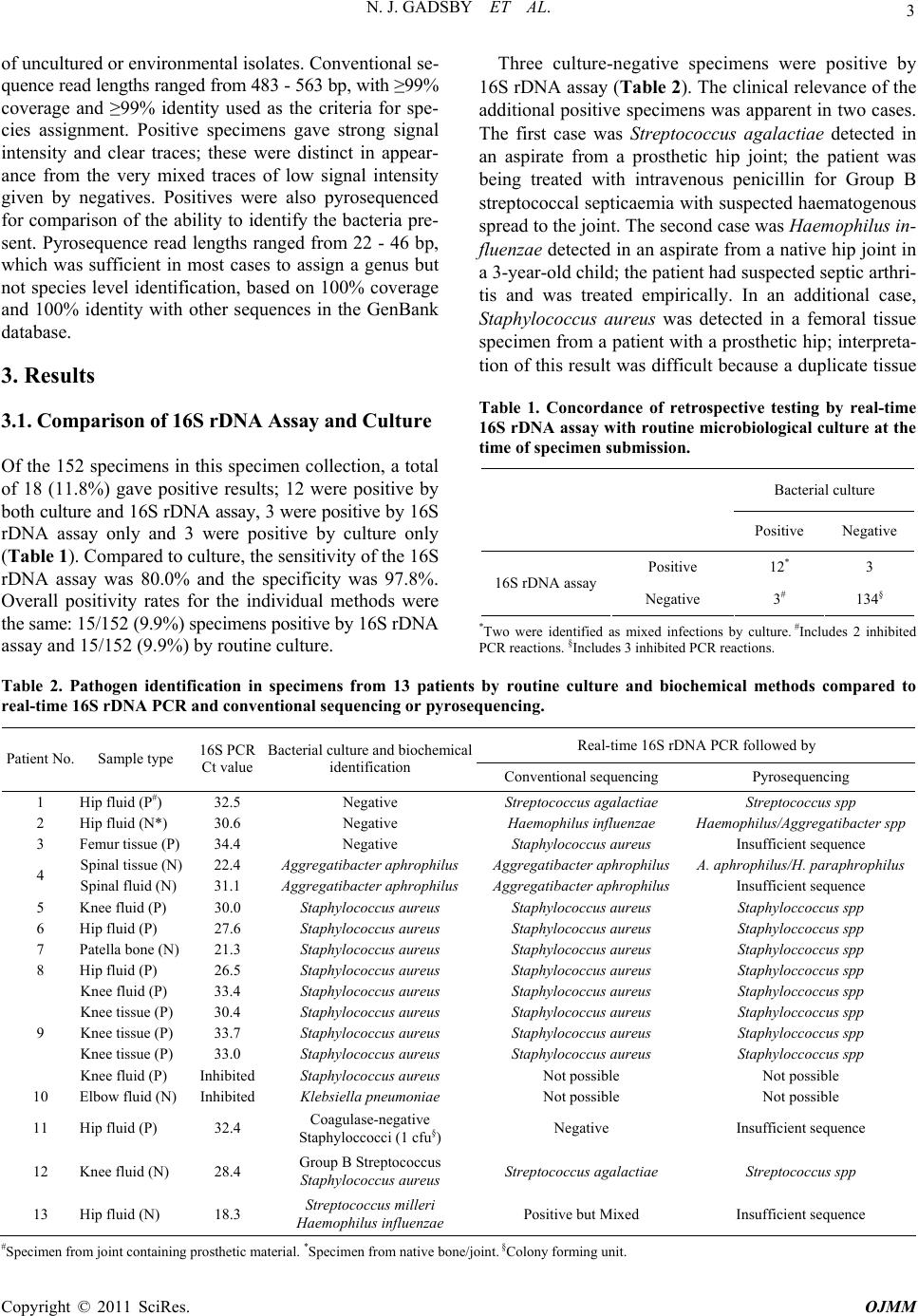 N. J. GADSBY ET AL. Copyright © 2011 SciRes. OJMM 3 of uncultured or environmental isolates. Conventional se- quence read lengths ranged from 483 - 563 bp, with ≥99% coverage and ≥99% identity used as the criteria for spe- cies assignment. Positive specimens gave strong signal intensity and clear traces; these were distinct in appear- ance from the very mixed traces of low signal intensity given by negatives. Positives were also pyrosequenced for comparison of the ability to identify the bacteria pre- sent. Pyrosequence read lengths ranged from 22 - 46 bp, which was sufficient in most cases to assign a genus but not species level identification, based on 100% coverage and 100% identity with other sequences in the GenBank database. 3. Results 3.1. Comparison of 16S rDNA Assay and Culture Of the 152 specimens in this specimen collection, a total of 18 (11.8%) gave positive results; 12 were positive by both culture and 16S rDNA assay, 3 were positive by 16S rDNA assay only and 3 were positive by culture only (Table 1). Compared to culture, the sensitivity of the 16S rDNA assay was 80.0% and the specificity was 97.8%. Overall positivity rates for the individual methods were the same: 15/152 (9.9%) specimens positive by 16S rDNA assay and 15/152 (9.9%) by routine culture. Three culture-negative specimens were positive by 16S rDNA assay (Table 2). The clinical relevance of the additional positive specimens was apparent in two cases. The first case was Streptococcus agalactiae detected in an aspirate from a prosthetic hip joint; the patient was being treated with intravenous penicillin for Group B streptococcal septicaemia with suspected haematogenous spread to the joint. The second case was Haemophilus in- fluenzae detected in an aspirate from a native hip joint in a 3-year-old child; the patient had suspected septic arthri- tis and was treated empirically. In an additional case, Staphylococcus aureus was detected in a femoral tissue specimen from a patient with a prosthetic hip; interpreta- tion of this result was difficult because a duplicate tissue Table 1. Concordance of retrospective testing by real-time 16S rDNA assay with routine microbiological culture at the time of specimen submission. Bacterial culture Positive Negative Positive 12* 3 16S rDNA assay Negative 3# 134§ *Two were identified as mixed infections by culture. #Includes 2 inhibited PCR reactions. §Includes 3 inhibited PCR reactions. Table 2. Pathogen identification in specimens from 13 patients by routine culture and biochemical methods compared to real-time 16S rDNA PCR and conventional sequencing or pyrosequencing. Real-time 16S rDNA PCR followed by Patient No. Sample type 16S PCR Ct value Bacterial culture and biochemical identification Conventional sequencing Pyrosequencing 1 Hip fluid (P#) 32.5 Negative Streptococcus agalactiae Streptococcus spp 2 Hip fluid (N*) 30.6 Negative Haemophilus influenzae Haemophilus/Aggregatibacter spp 3 Femur tissue (P) 34.4 Negative Staphylococcus aureus Insufficient sequence Spinal tissue (N) 22.4 Aggregatibacter aphrophilus Aggregatibacter aphrophilus A. aphrophilus/H. paraphrophilus 4 Spinal fluid (N) 31.1 Aggregatibacter aphrophilus Aggregatibacter aphrophil us Insufficient sequence 5 Knee fluid (P) 30.0 Staphylococcus aureus Staphylococcus aureus Staphyloccoccus spp 6 Hip fluid (P) 27.6 Staphylococcus aureus Staphylococ cus aureus Staphyl occoccus spp 7 Patella bone (N) 21.3 Staphylococcus aureus Staphylococcus aureus Staphyloccoccus spp 8 Hip fluid (P) 26.5 Staphylococcus aureus Staphylococ cus aureus Staphyl occoccus spp Knee fluid (P) 33.4 Staphylococcus aureus Staphylococcus aureus Staphyloccoccus spp Knee tissue (P) 30.4 Staphylococcus aureus Staphylococcus aureus Staphyloccoccus spp Knee tissue (P) 33.7 Staphylococcus aureus Staphylococcus aureus Staphyloccoccus spp Knee tissue (P) 33.0 Staphylococcus aureus Staphylococcus aureus Staphyloccoccus spp 9 Knee fluid (P) Inhibited Staphylococcus aureus Not possible Not possible 10 Elbow fluid (N) Inhibited Klebsiella pneumoniae Not possible Not possible 11 Hip fluid (P) 32.4 Coagulase-negative Staphyloccocci (1 cfu§) Negative Insufficient sequence 12 Knee fluid (N) 28.4 Group B Streptococcus Staphylococcus aureus Streptococcus agalactiae Streptococcus spp 13 Hip fluid (N) 18.3 Streptococcus milleri Haemophilus influenzae Positive but Mixed Insufficient sequence #Specimen from joint containing prosthetic material. *Specimen from native bone/joint. §Colony forming unit. 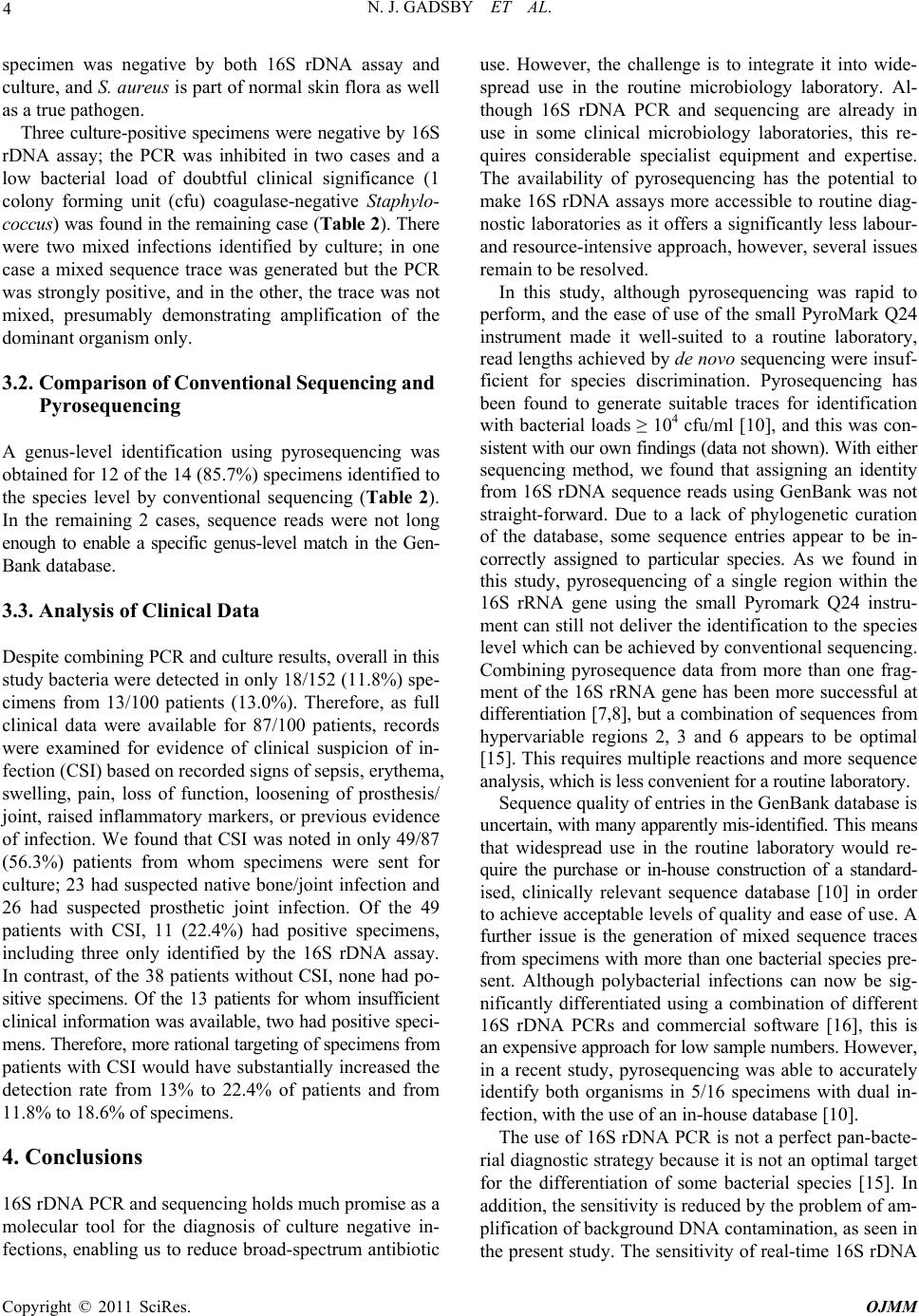 N. J. GADSBY ET AL. Copyright © 2011 SciRes. OJMM 4 specimen was negative by both 16S rDNA assay and culture, and S. aureus is part of normal skin flora as well as a true pathogen. Three culture-positive specimens were negative by 16S rDNA assay; the PCR was inhibited in two cases and a low bacterial load of doubtful clinical significance (1 colony forming unit (cfu) coagulase-negative Staphylo- coccus) was found in the remaining case (Table 2). There were two mixed infections identified by culture; in one case a mixed sequence trace was generated but the PCR was strongly positive, and in the other, the trace was not mixed, presumably demonstrating amplification of the dominant organism only. 3.2. Comparison of Conventional Sequencing and Pyrosequencing A genus-level identification using pyrosequencing was obtained for 12 of the 14 (85.7%) specimens identified to the species level by conventional sequencing (Table 2). In the remaining 2 cases, sequence reads were not long enough to enable a specific genus-level match in the Gen- Bank database. 3.3. Analysis of Clinical Data Despite combining PCR and culture results, overall in this study bacteria were detected in only 18/152 (11.8%) spe- cimens from 13/100 patients (13.0%). Therefore, as full clinical data were available for 87/100 patients, records were examined for evidence of clinical suspicion of in- fection (CSI) based on recorded signs of sepsis, erythema, swelling, pain, loss of function, loosening of prosthesis/ joint, raised inflammatory markers, or previous evidence of infection. We found that CSI was noted in only 49/87 (56.3%) patients from whom specimens were sent for culture; 23 had suspected native bone/joint infection and 26 had suspected prosthetic joint infection. Of the 49 patients with CSI, 11 (22.4%) had positive specimens, including three only identified by the 16S rDNA assay. In contrast, of the 38 patients without CSI, none had po- sitive specimens. Of the 13 patients for whom insufficient clinical information was available, two had positive speci- mens. Therefore, more rational targeting of specimens from patients with CSI would have substantially increased the detection rate from 13% to 22.4% of patients and from 11.8% to 18.6% of specimens. 4. Conclusions 16S rDNA PCR and sequencing holds much promise as a molecular tool for the diagnosis of culture negative in- fections, enabling us to reduce broad-spectrum antibiotic use. However, the challenge is to integrate it into wide- spread use in the routine microbiology laboratory. Al- though 16S rDNA PCR and sequencing are already in use in some clinical microbiology laboratories, this re- quires considerable specialist equipment and expertise. The availability of pyrosequencing has the potential to make 16S rDNA assays more accessible to routine diag- nostic laboratories as it offers a significantly less labour- and resource-intensive approach, however, several issues remain to be resolved. In this study, although pyrosequencing was rapid to perform, and the ease of use of the small PyroMark Q24 instrument made it well-suited to a routine laboratory, read lengths achieved by de novo sequencing were insuf- ficient for species discrimination. Pyrosequencing has been found to generate suitable traces for identification with bacterial loads ≥ 104 cfu/ml [10], and this was con- sistent with our own findings (data not shown). With either sequencing method, we found that assigning an identity from 16S rDNA sequence reads using GenBank was not straight-forward. Due to a lack of phylogenetic curation of the database, some sequence entries appear to be in- correctly assigned to particular species. As we found in this study, pyrosequencing of a single region within the 16S rRNA gene using the small Pyromark Q24 instru- ment can still not deliver the identification to the species level which can be achieved by conventional sequencing. Combining pyrosequence data from more than one frag- ment of the 16S rRNA gene has been more successful at differentiation [7,8], but a combination of sequences from hypervariable regions 2, 3 and 6 appears to be optimal [15]. This requires multiple reactions and more sequence analysis, which is less convenient for a routine laboratory. Sequence quality of entries in the GenBank database is uncertain, with many apparently mis-identified. This means that widespread use in the routine laboratory would re- quire the purchase or in-house construction of a standard- ised, clinically relevant sequence database [10] in order to achieve acceptable levels of quality and ease of use. A further issue is the generation of mixed sequence traces from specimens with more than one bacterial species pre- sent. Although polybacterial infections can now be sig- nificantly differentiated using a combination of different 16S rDNA PCRs and commercial software [16], this is an expensive approach for low sample numbers. However, in a recent study, pyrosequencing was able to accurately identify both organisms in 5/16 specimens with dual in- fection, with the use of an in-house database [10]. The use of 16S rDNA PCR is not a perfect pan-bacte- rial diagnostic strategy because it is not an optimal target for the differentiation of some bacterial species [15]. In addition, the sensitivity is reduced by the problem of am- plification of background DNA contamination, as seen in the present study. The sensitivity of real-time 16S rDNA  N. J. GADSBY ET AL. Copyright © 2011 SciRes. OJMM 5 PCR and sequencing compares relatively unfavourably to pathogen-specific real-time PCR, being at least 10-fold less sensitive [13]. Therefore, specimens with low bacte- rial loads will be missed by using this technique; this may be a particular problem in specimens from prosthetic joint infections where bacteria are likely to be present largely in biofilms. However, as illustrated in this study, it is very useful in identifying bacteria present at higher levels but which are unlikely to grow on conventional culture media due to their fastidious nature or prior anti- biotic treatment. Alternative molecular methods, such as performing a battery of species-specific PCR reactions on 16S rDNA assay positive specimens [17], may cir- cumvent the need for sequencing, but only enable detec- tion of the limited number of organisms actively sought. In this study, a 16S rDNA PCR assay was used to re- trospectively test 152 joint fluid and tissue specimens for comparison to routine microbiological culture. We found good concordance between conventional culture methods and 16S rDNA PCR, and were able to identify a small number of clinically significant additional positive re- sults. There were no potential false positives using 16S rDNA PCR and sequencing since all identifications were concordant with culture, and clinically relevant pathogens were detected in the three PCR positive cases which were culture-negative. However, overall positivity rates were unexpectedly low, therefore a full evaluation of the ef- fectiveness of the 16S rDNA PCR assay compared to con- ventional culture in joint fluid and tissue specimens will require a larger study. In this study, combining results from both molecular and conventional culture methods, bacteria were only detected in 18/152 (11.8%) specimens. Other similar studies have described composite culture and 16S rDNA PCR detection rates ranging from 18.5% - 62.5% in joint specimens [1,2,17-19]. Further investi- gation revealed a significant proportion of specimens in this study (56%) were sent from patients without a docu- mented suspicion of infection. Therefore, testing a subset of the received specimens, based on good clinical infor- mation, would have increased the detection rate from 11.8% to 18.6% of specimens and from 13% to 22.4% of patients. As even a single additional positive result is im- portant for the management of the individual patient, this molecular assay would be a beneficial addition to routine culture, but only where specific clinical criteria are met; opportunistic sampling to exclude bacterial infection should be discouraged. In conclusion, while pyrosequencing had significant advantages in speed and ease-of-use over conventional sequencing, multiple reactions are required to deliver com- parable species-level identification, thus negating many of the benefits of using the technique. Furthermore, 16S rDNA PCR should be rationally targeted on the basis of good clinical information in the routine diagnostic setting, and not used as a general screening test for the exclusion of bacterial infection in joint specimens. 5. Acknowledgements The authors thank Mr Andrew Mitchell for assistance in obtaining data from the laboratory results database and the staff of the Microbiology Laboratory, Royal Infir- mary of Edinburgh. This work was supported by NHS Education for Scotland (NES) through the Clinical Sci- entist Training Programme. Part of this study was pre- sented in poster format at the 21st European Congress of Clinical Microbiology and Infectious Diseases on 9th May 2011. The authors declare no conflicts of interest. 6. References [1] F. Fenollar, V. Roux, A. Stein, M. Drancourt and D. Raoult, “Analysis of 525 Samples to Determine the Use- fulness of PCR Amplification and Sequencing of the 16S rRNA Gene for Diagnosis of Bone and Joint Infections,” Journal of Clinical Microbiology, Vol. 44, No. 3, 2006, pp. 1018-1028. doi:10.1128/JCM.44.3.1018-1028.2006 [2] A. L. Rosey, E. Abachin, G. Quesnes, C. Cadilhac, Z. Pejin, C. Glorion, P. Berche and A Ferroni, “Development of a Broad-Range 16S rDNA Real-Time PCR for the Diagno- sis of Septic Arthritis in Children,” Journal of Microbi- ological Methods, Vol. 68, No. 1, 2007, pp. 88-93. doi:10.1016/j.mimet.2006.06.010 [3] P. E. Fournier, F. Thuny, H. Richet, H. Lepidi, J. P. Casalta, J. P. Arzouni, M. Maurin, M. Célard, J. L. Mainardi, T. Caus, F. Collart, G. Habib and D. Raoult, “Comprehen- sive Diagnostic Strategy for Blood Culture-Negative En- docarditis: A Prospective Study of 819 New Cases,” Clini- cal Infectious Diseases, Vol. 51, No. 2, 2010, pp. 131- 140. doi:10.1086/653675 [4] K. A. Harris and J. C. Hartley, “Development of Broad- Range 16S rDNA PCR for Use in the Routine Diagnostic Clinical Microbiology Service,” Journal of Medical Mi- crobiology, Vol. 52, No. 8, 2003, pp. 685-691. doi:10.1099/jmm.0.05213-0 [5] A. Ahmadian, M. Ehn and S. Hober, “Pyrosequencing: History, Biochemistry and Future,” Clinica Chimica Acta, Vol. 363, No. 1-2, 2006, pp. 83-94. doi:10.1016/j.cccn.2005.04.038 [6] N. Kobayashi, T. W. Bauer, M. J. Tuohy, I. H. Lieberman, V. Krebs, D. Togawa, T. Fujishiro and G. W. Procop, “The Comparison of Pyrosequencing Molecular Gram Stain, Culture and Conventional Gram Stain for Diag- nosing Orthopaedic Infections,” Journal of Orthopaedic Research, Vol. 24, No. 8, 2006, pp. 1641-1649. doi:10.1002/jor.20202 [7] J. A. Jordan, A. R. Butchko and M. B. Durso, “Use of Pyrosequencing of 16S rRNA Fragments to Differentiate between Bacteria Responsible for Neonatal Sepsis,” The 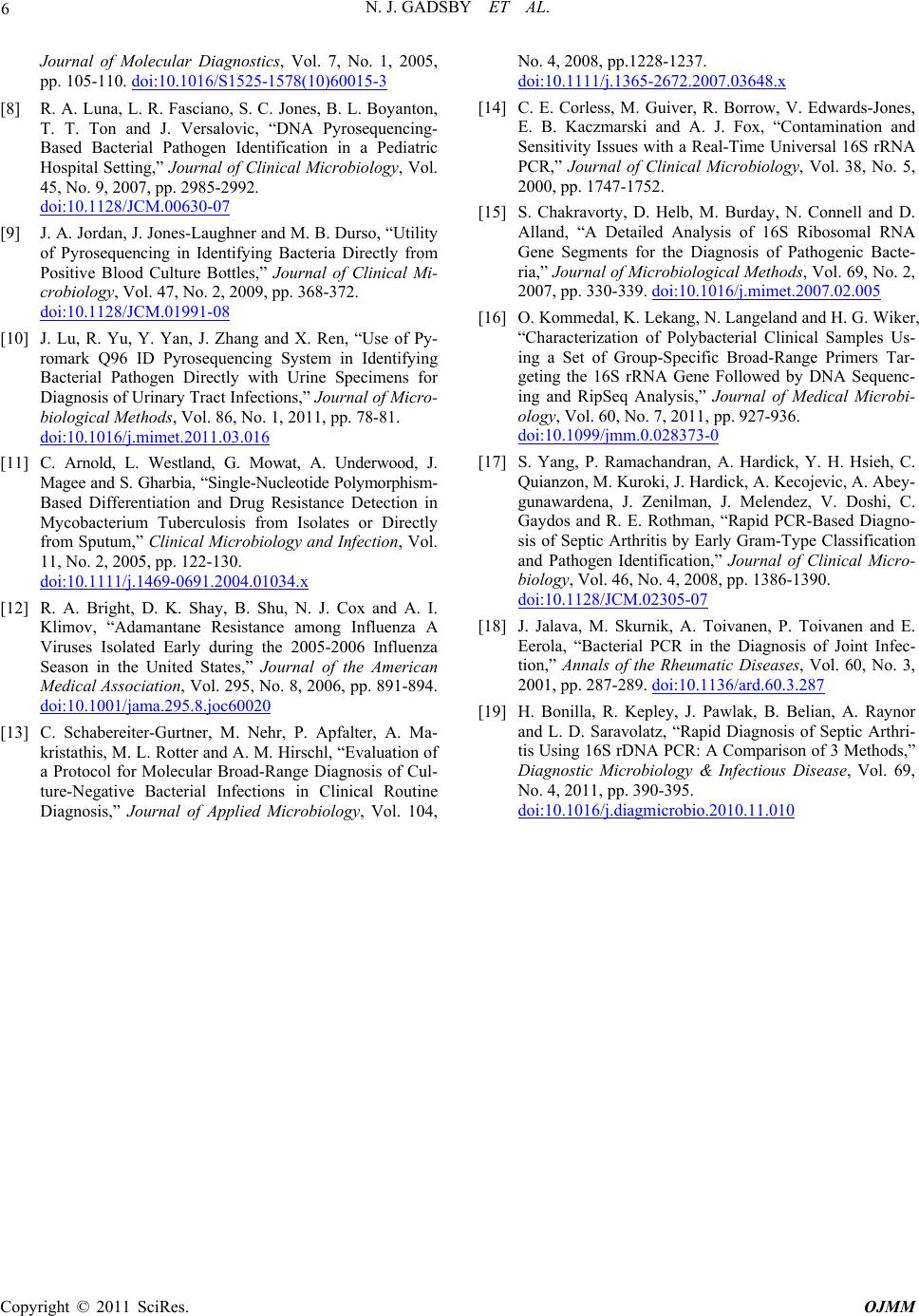 N. J. GADSBY ET AL. Copyright © 2011 SciRes. OJMM 6 Journal of Molecular Diagnostics, Vol. 7, No. 1, 2005, pp. 105-110. doi:10.1016/S1525-1578(10)60015-3 [8] R. A. Luna, L. R. Fasciano, S. C. Jones, B. L. Boyanton, T. T. Ton and J. Versalovic, “DNA Pyrosequencing- Based Bacterial Pathogen Identification in a Pediatric Hospital Setting,” Journal of Clinical Microbiology, Vol. 45, No. 9, 2007, pp. 2985-2992. doi:10.1128/JCM.00630-07 [9] J. A. Jordan, J. Jones-Laughner and M. B. Durso, “Utility of Pyrosequencing in Identifying Bacteria Directly from Positive Blood Culture Bottles,” Journal of Clinical Mi- crobiology, Vol. 47, No. 2, 2009, pp. 368-372. doi:10.1128/JCM.01991-08 [10] J. Lu, R. Yu, Y. Yan, J. Zhang and X. Ren, “Use of Py- romark Q96 ID Pyrosequencing System in Identifying Bacterial Pathogen Directly with Urine Specimens for Diagnosis of Urinary Tract Infections,” Journal of Micro- biological Methods, Vol. 86, No. 1, 2011, pp. 78-81. doi:10.1016/j.mimet.2011.03.016 [11] C. Arnold, L. Westland, G. Mowat, A. Underwood, J. Magee and S. Gharbia, “Single-Nucleotide Polymorphism- Based Differentiation and Drug Resistance Detection in Mycobacterium Tuberculosis from Isolates or Directly from Sputum,” Clinical Microbiology and Infection, Vol. 11, No. 2, 2005, pp. 122-130. doi:10.1111/j.1469-0691.2004.01034.x [12] R. A. Bright, D. K. Shay, B. Shu, N. J. Cox and A. I. Klimov, “Adamantane Resistance among Influenza A Viruses Isolated Early during the 2005-2006 Influenza Season in the United States,” Journal of the American Medical Association, Vol. 295, No. 8, 2006, pp. 891-894. doi:10.1001/jama.295.8.joc60020 [13] C. Schabereiter-Gurtner, M. Nehr, P. Apfalter, A. Ma- kristathis, M. L. Rotter and A. M. Hirschl, “Evaluation of a Protocol for Molecular Broad-Range Diagnosis of Cul- ture-Negative Bacterial Infections in Clinical Routine Diagnosis,” Journal of Applied Microbiology, Vol. 104, No. 4, 2008, pp.1228-1237. doi:10.1111/j.1365-2672.2007.03648.x [14] C. E. Corless, M. Guiver, R. Borrow, V. Edwards-Jones, E. B. Kaczmarski and A. J. Fox, “Contamination and Sensitivity Issues with a Real-Time Universal 16S rRNA PCR,” Journal of Clinical Microbiology, Vol. 38, No. 5, 2000, pp. 1747-1752. [15] S. Chakravorty, D. Helb, M. Burday, N. Connell and D. Alland, “A Detailed Analysis of 16S Ribosomal RNA Gene Segments for the Diagnosis of Pathogenic Bacte- ria,” Journal of Microbiological Methods, Vol. 69, No. 2, 2007, pp. 330-339. doi:10.1016/j.mimet.2007.02.005 [16] O. Kommedal, K. Lekang, N. Langeland and H. G. Wiker, “Characterization of Polybacterial Clinical Samples Us- ing a Set of Group-Specific Broad-Range Primers Tar- geting the 16S rRNA Gene Followed by DNA Sequenc- ing and RipSeq Analysis,” Journal of Medical Microbi- ology, Vol. 60, No. 7, 2011, pp. 927-936. doi:10.1099/jmm.0.028373-0 [17] S. Yang, P. Ramachandran, A. Hardick, Y. H. Hsieh, C. Quianzon, M. Kuroki, J. Hardick, A. Kecojevic, A. Abey- gunawardena, J. Zenilman, J. Melendez, V. Doshi, C. Gaydos and R. E. Rothman, “Rapid PCR-Based Diagno- sis of Septic Arthritis by Early Gram-Type Classification and Pathogen Identification,” Journal of Clinical Micro- biology, Vol. 46, No. 4, 2008, pp. 1386-1390. doi:10.1128/JCM.02305-07 [18] J. Jalava, M. Skurnik, A. Toivanen, P. Toivanen and E. Eerola, “Bacterial PCR in the Diagnosis of Joint Infec- tion,” Annals of the Rheumatic Diseases, Vol. 60, No. 3, 2001, pp. 287-289. doi:10.1136/ard.60.3.287 [19] H. Bonilla, R. Kepley, J. Pawlak, B. Belian, A. Raynor and L. D. Saravolatz, “Rapid Diagnosis of Septic Arthri- tis Using 16S rDNA PCR: A Comparison of 3 Methods,” Diagnostic Microbiology & Infectious Disease, Vol. 69, No. 4, 2011, pp. 390-395. doi:10.1016/j.diagmicrobio.2010.11.010 |

